Content
Kinematics: Typical Cases of Tangential Motion
The object moves in a straight line
The object moves in a curved path with constant speed
The object moves in a curved path with constant speed and constant normal
acceleration component
The object moves in a curved path with constant
tangential
acceleration component
The object moves in a fixed curved path y=f(x), the radius of
curvature ρ along the path can be expressed in term of the rate of change of the
function
Kinematics: Typical Cases of Tangential Motion
In practical engineering problems, there are some typical cases of tangential motion.
The object moves in a straight line
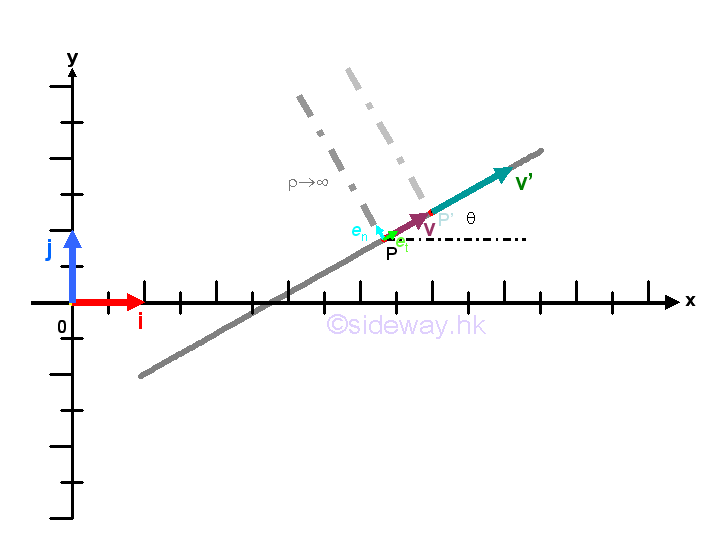
When an object moves in a straight line, the radius of curvature ρ is equal to infinity. Since the normal acceleration component an is inversily propertional to the radius of curvature ρ, the normal acceleration component an is equal to zerol and the acceleration a of the motion is equal to the tangential acceleration componet at only, which is equal to the time rate of change in the magnitude of the velocity dv/dt. In other words, when an object in curvilinear motion, if the radius of curvature tends to infinity, the normal acceleration component of the object approaches zero also. Imply
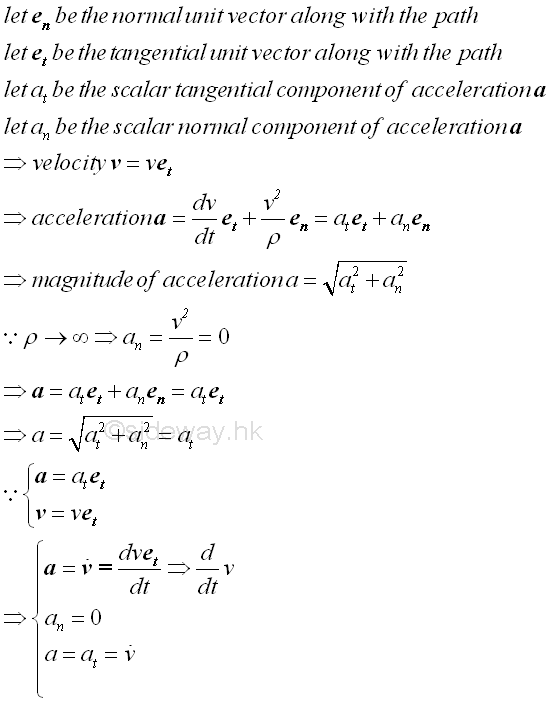
The object moves in a curved path with constant speed
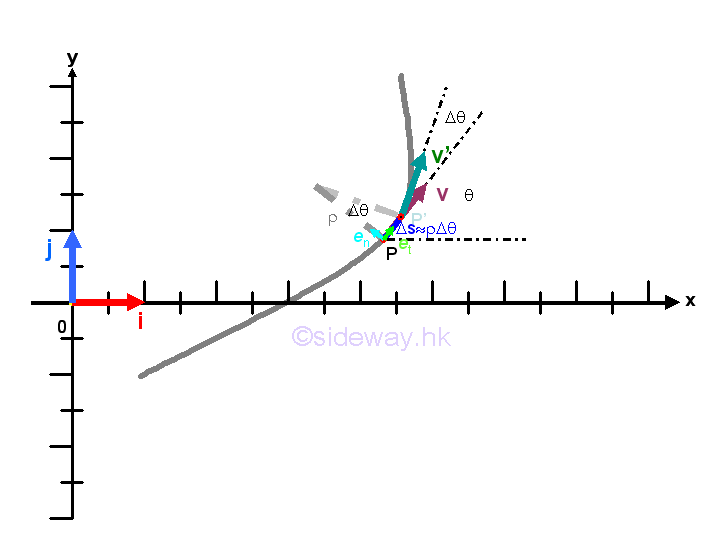
When an object moves in a curved path at constant speed, the tangential acceleration component at along with the tangential velocity component vt which is equal to the speed of the object v, is equal to zero and the acceleration a of the motion is equal to the normal acceleration componet an only, which is equal to the time rate of change in the direction of the velocity. In other words, when an object in curvilinear motion, the normal acceleration component of the object mush not be equal to zero, and the radius of curvature ρ should also be tend to an finite value. Imply
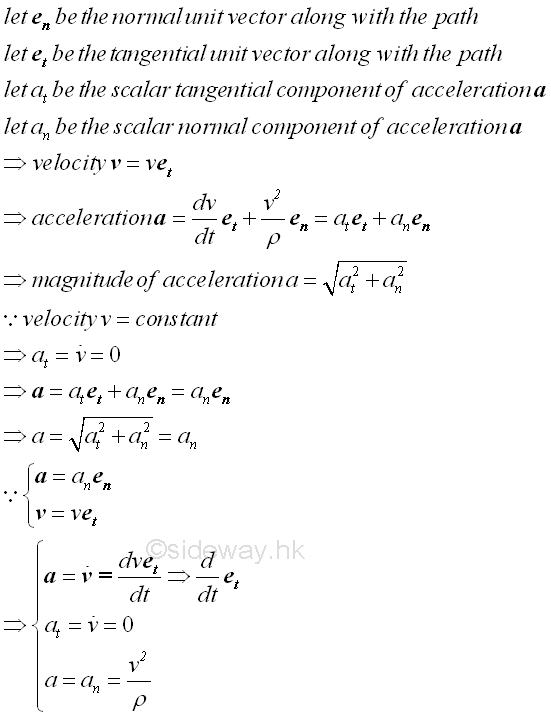
The object moves in a curved path with constant speed and constant normal acceleration component
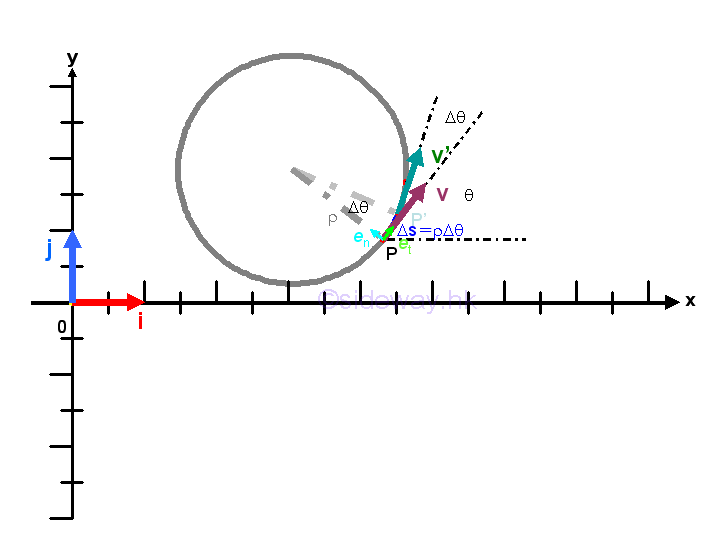
When an object moves in a curved path at constant speed, the tangential acceleration component at along with the tangential velocity component vt which is equal to the speed of the object v, is equal to zero and the acceleration a of the motion is equal to the normal acceleration componet an only, which is equal to the time rate of change in the direction of the velocity. Since the speed of the object is constant, if the normal acceleration component is also a constant, then the radius of curvature ρ should be a constant aslo. In other words, when an object in curvilinear motion, if both the speed and the normal acceleration component of the object are constants, the object is in uniform circular motion with the constant radius of curvature ρ which is equal to the radius of the circular motion. Imply
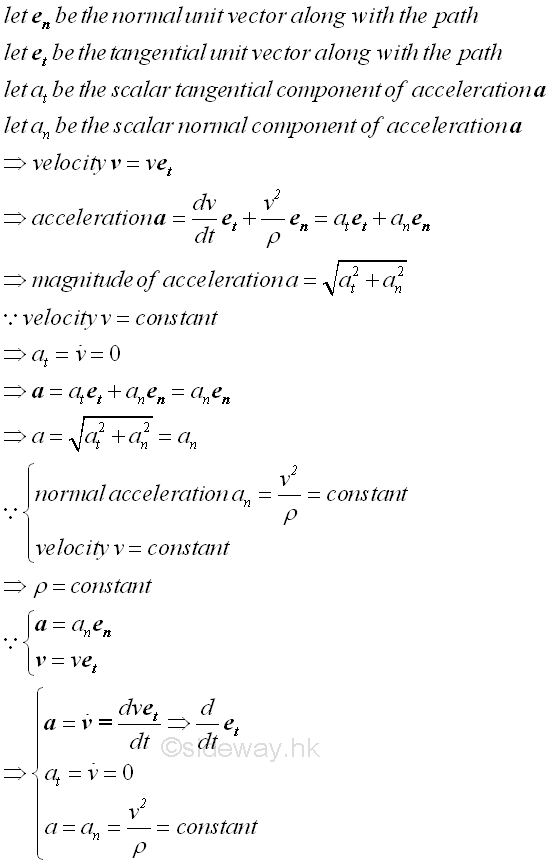
For an uniform circular motion, both the radius of curvature ρ and the tangential speed v are constant. Therefore the distance traveled can be expressed in term of the time interval Δt or the change in angle Δθ during time interval Δt. And time interval Δt can then be expressed in term of change in angle Δθ. The change in velocity can also be obtained trigonometrically and be expressed in term of a sine function of change in angle Δθ. By taking limit as the change in angle Δθ approaching zero. the magnitude of acceleration a can then be determined and the direction of the acceleration is always be towards the centre of the circular motion. Imply
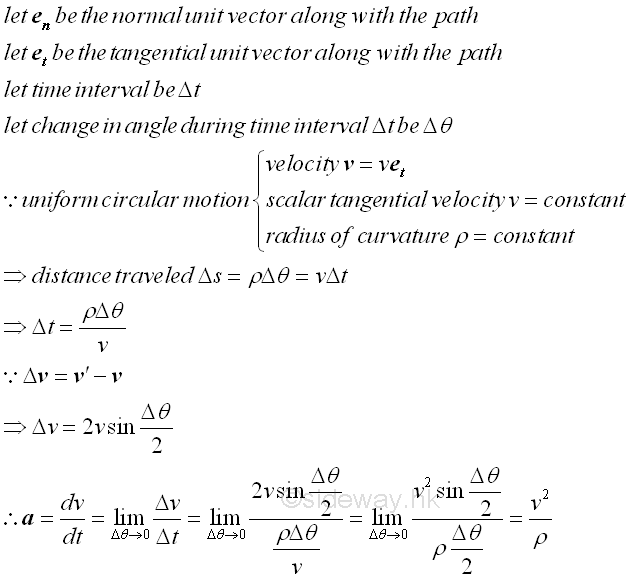
The object moves in a curved path with constant tangential acceleration component
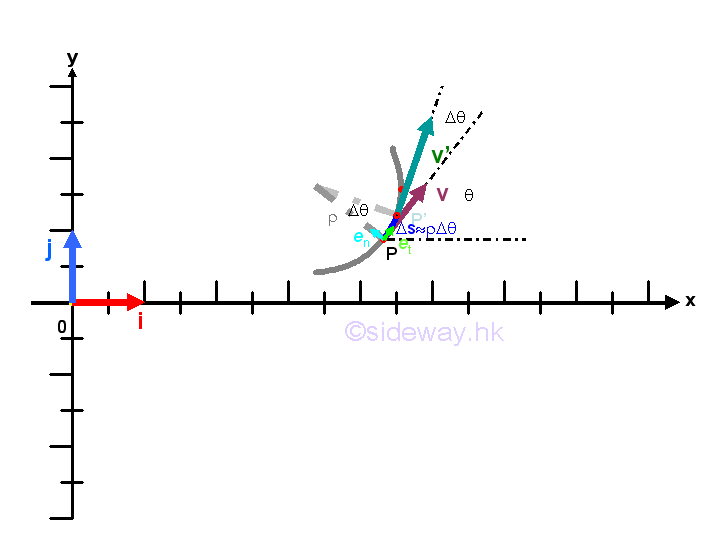
When an object moves in a curved path with constant tangential acceleration component, the normal acceleration component an normal to the tangential velocity component vt should not be equal to zero otherwise the object is in a rectilinear motion. Since there is no normal velocity component vn and the tangential velocity component vt is always along with the motion of the object, the equations of tangential motion are similar to those equations of linear motion. Imply
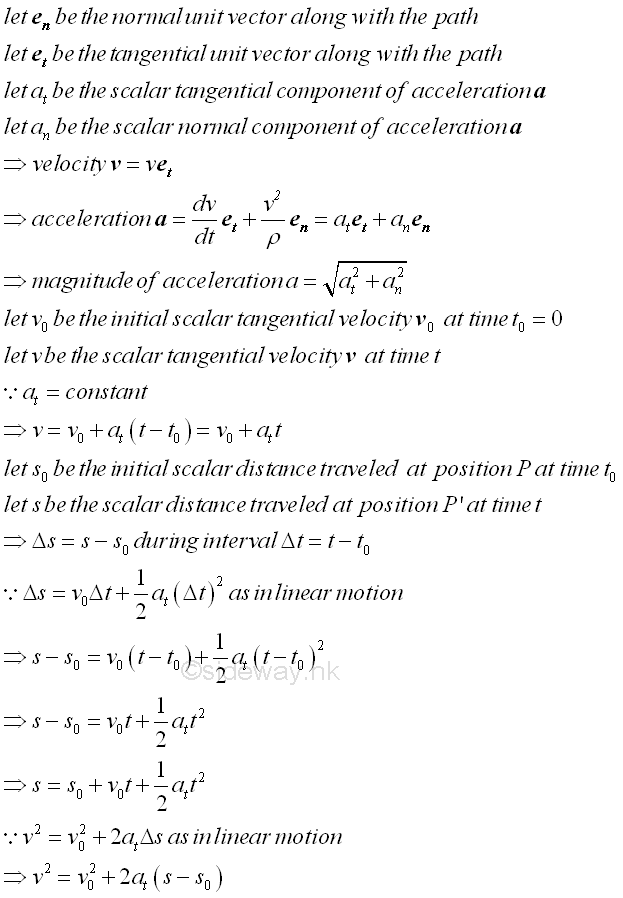
The object moves in a fixed curved path y=f(x), the radius of curvature ρ along the path can be expressed in term of the rate of change of the function
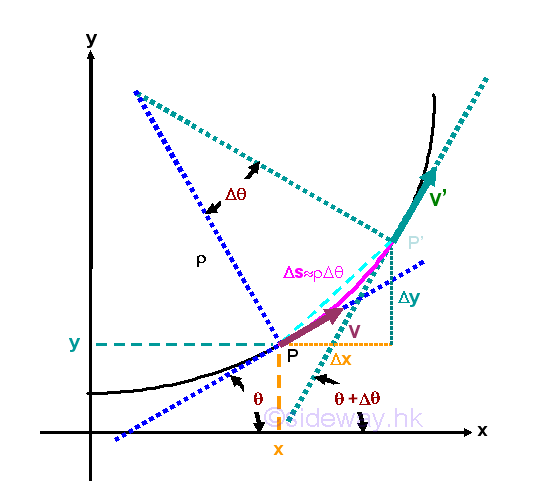
When an object moves in a fixed curved path y=f(x), the radius of curvature ρ along the path can be expressed in term of the rate of change of the function. The radius of curvature ρ can be expressed in term of the rate of change of traveled distance Δs with respect to the angle θ when taking limit as Δθ approaching zero. Since both Δs and Δθ are functions of x also, the radius of curvature ρ can then be expressed in term of the rate of change of the function y=f(x) by making use of the Pythagorean theorem and the slope of the function. Imply
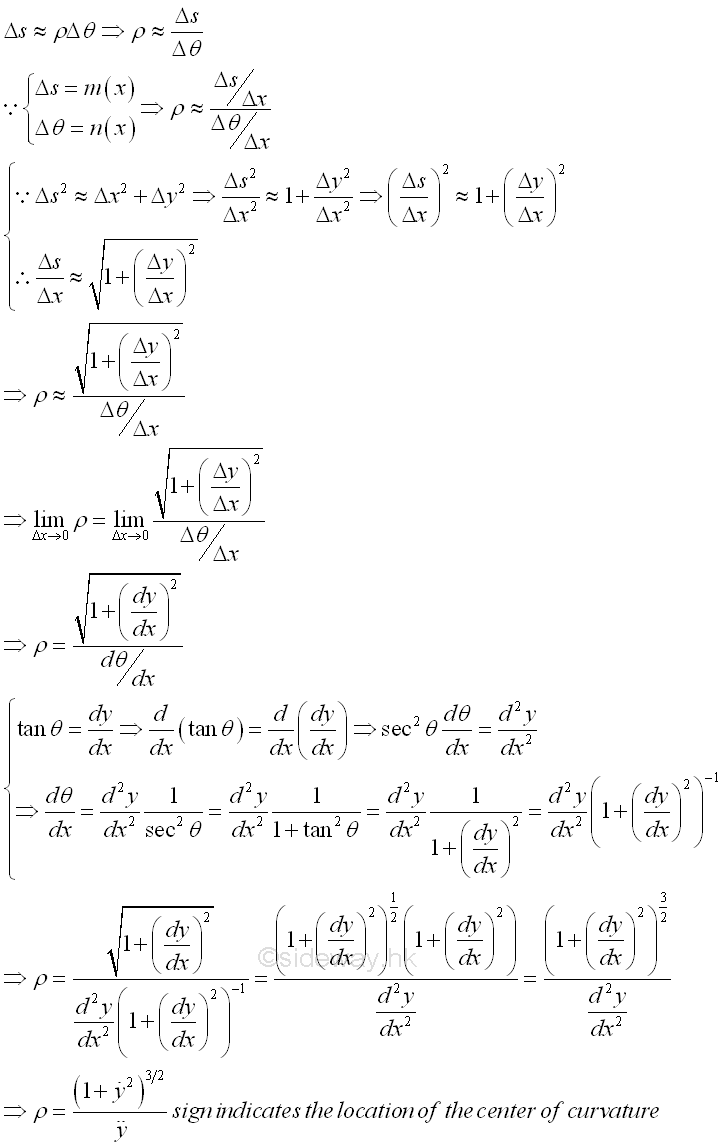
©sideway
ID: 140300003 Last Updated: 3/10/2014 Revision: 0 Ref:
References
- I.C. Jong; B.G. rogers, 1991, Engineering Mechanics: Statics and Dynamics
- F.P. Beer; E.R. Johnston,Jr.; E.R. Eisenberg, 2004, Vector Mechanics for Engineers: Statics
Latest Updated Links
- Panasonic SR-CK05 RiceCooker CW-HZ70AA(last updated On 11/17/2025)
- Panasonic Hood Structure Ventilating Fan Blade Diameter: 8in FV-20WH307 CW-HZ70AA(last updated On 11/16/2025)
- Panasonic Window Mount Thermo Ventilator FV-30BW2H CW-HZ70AA(last updated On 11/15/2025)
- Panasonic Inverter PRO Inverter Window Heatpump Air-Conditioner (3/4 HP) CW-HZ70AA(last updated On 11/14/2025)
- Panasonic Inverter Window-Split Type Cooling Only Air-Conditioner (1 HP) CS-U9YWA(last updated On 11/13/2025)
- Panasonic Inverter Steam and Grill_Microwave Oven 27L NN_DS59NB(last updated On 11/12/2025)
- Panasonic KY-C223B Induction Cooker(last updated On 11/11/2025)
- Focus M41 Single lever kitchen mixer 160(last updated On 11/10/2025)
- Focus Single lever basin mixer 230(last updated On 11/9/2025)
- Precision Start Thermostat shower mixer(last updated On 11/8/2025)
- Tempesta 100 Shower Rail Set 3 sprays(last updated On 11/7/2025)

 Nu Html Checker
Nu Html Checker  53
53  na
na  na
na
Home 5
Business
Management
HBR 3
Information
Recreation
Hobbies 8
Culture
Chinese 1097
English 339
Travel 18
Reference 79
Hardware 40![]()
Computer
Hardware 259
Software
Application 213
Digitization 37
Latex 52
Manim 205
KB 1
Numeric 19
Programming
Web 289
Unicode 504
HTML 66
CSS 65
SVG 46
ASP.NET 270
OS 431
DeskTop 7
Python 72
Knowledge
Mathematics
Formulas 8
Set 1
Logic 1
Algebra 84
Number Theory 206
Trigonometry 31
Geometry 34
Calculus 67
Engineering
Tables 8
Mechanical
Rigid Bodies
Statics 92
Dynamics 37
Fluid 5
Control
Acoustics 19
Natural Sciences
Matter 1
Electric 27
Biology 1
